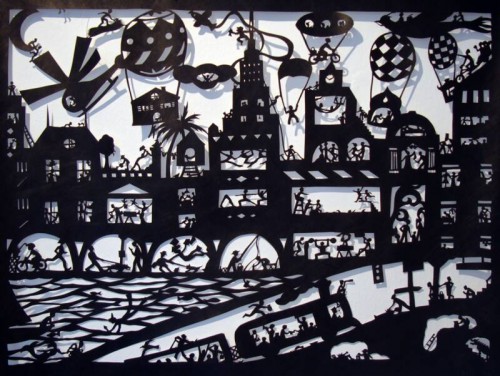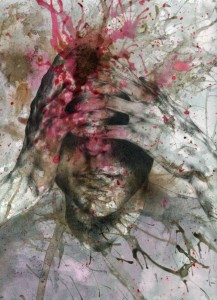Interview with Angela Leroux-Lindsey of The Adirondack Review
I’ve always been curious about the darkroom where literary magazines come together. This is a series of interviews engaging, talking, and sometimes annoying editors about their magazines. How did they come about, what do they hate about editing, and what do they love most about it? This is the first in the series and I talked with Angela Leroux-Lindsey of The Adirondack Review. The visual imagery is simply stunning. The Adirondack Review is like an art gallery curated online, constantly evolving, fused together with great stories, poetry, and essays. In preparation for the interview, I pretty much went through the entire archives and got a brain dump, Matrix-style, in art and photography. A jolt to the system is what I like feeling with my lit magazines and reading directly from their about page: “The Adirondack Review is an independent online quarterly magazine of literature and the arts dedicated to publishing poetry, fiction, artwork, and photography, as well as interviews, articles, book reviews, and translations. Recently named a ‘great online literary magazine’ by Esquire and a ‘top online journal’ by The Huffington Post, TAR was established in the spring of 2000, with its first issue appearing that summer.”
As a brief bio and introduction to Angela Leroux-Lindsey:
Angela Leroux-Lindsey is editor of The Adirondack Review and senior editor with Black Lawrence Press. She writes for Kirkus Reviews and A&U Magazine, and has contributed essays and stories to phys.org, Animal Farm, Innovation Magazine, NY Metro, Brookhaven National Laboratory, and others. She lives in Brooklyn.
***
PTL: Can you tell us about the review, how did The Adirondack Review first get its inception and how did you first get involved?
Angela Leroux-Lindsey: The magazine has actually been around since the summer of 2000—the founder editor, Colleen Ryor, was sort of a pioneer in never going to print, which is something I’ve always admired. But I didn’t start contributing until 2006 or 2007. At that point Diane Goettel was editing, and when she left to run Black Lawrence Press full-time, I took over. So my first issue was in the winter of 2009. A big part of the appeal was their early commitment to publishing art. I especially love how being online gives us the freedom to publish as much full-color art as we want; in the fall issue, I featured almost 30 images by five different artists and photographers. This is something we could never afford if we had to pay for ink and paper. We also publish poetry, fiction, and works in translation in every issue, a mix of mediums that I think is really lovely. Every time we close I’m sort of delighted to see unexpected threads emerge that tie completely different submissions together: a drawing that evokes the tension of post-apocalyptic familial relationships next to a story that takes place on a placid lake over the course of an afternoon but is really about survival. Discovering these entanglements and bringing so many different people together is so much fun. It’s the best job.
PTL: Each issue is packed with fiction, poetry, and some of the most incredible photography and art I’ve seen. What goes into the curating and selection process?
ALL: Well, like every small lit mag out there, I rely so much on my staff. We all volunteer, which makes it even more amazing that I’ve found a group of people willing to be so thoughtful and imaginative about how we compose issues. Nick Samaras, our poetry editor, came on board when I did and he’s brilliant. Google him, read his poetry, you’ll just swoon over it.
Regarding art, some of it comes in through the submission process, but a lot of it I solicit. Sometimes I’m just scrolling through tumblr and come across a piece that floors me. And I’m always completely thrilled when a big name that I’ve solicited says yes: I mean, Manfred Mohr was on the cover of the summer issue. I was watching some of his animated videos from the 70s on YouTube, and figured I’d send him an email to ask if he’d be interested in featuring some of his new stuff. And he emailed me back within a week and said yes. I’m still excited every time this happens. It’s magical. Richard Mosse is another example. I’m in love with his INFRA series, which is online now.
Really, getting to work with all of these artists and writers is absolutely the best part of having this role. Not just meeting new people and developing friendships—like with you, Peter—which I really value. But living in Brooklyn and getting to hang out with so many writers I admire is killer. You wouldn’t believe the people I’ve met and fallen completely to pieces in front of. I hosted a reading once with Paul Muldoon and could hardly pronounce my own name when I introduced myself. And then to watch emerging writers and artists who have published work with us go on to publish books or exhibit work at major galleries or museums is really awesome. My friend Kit Frick has a completely gorgeous chapbook coming out called Echo, Echo, Light from Slope Editions. We published early versions of a few of these poems in 2011 and I can’t wait to see how they’re incorporated into a collection. And Luba Lukova, a political artist whose work I sought out for the cover of the first issue I edited, will show at MoMA next month. Revisiting these issues and experiencing that kind of folding of time is a cool thing. It makes me think of the larger view of independent publishing as a sort of performance art space in itself.


